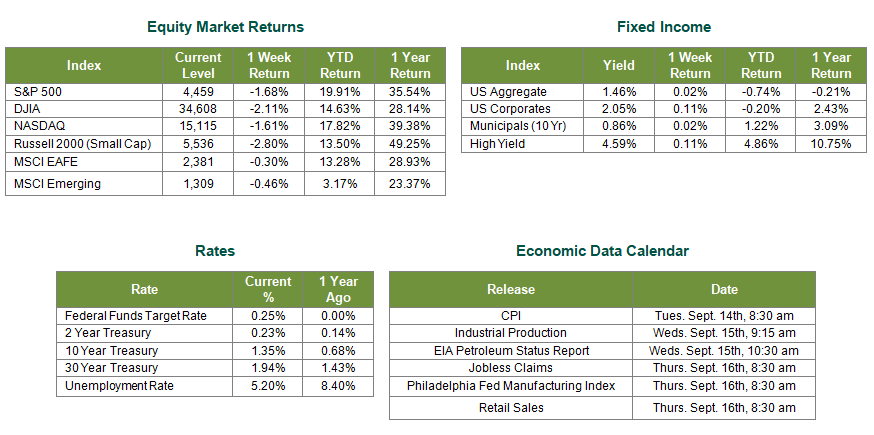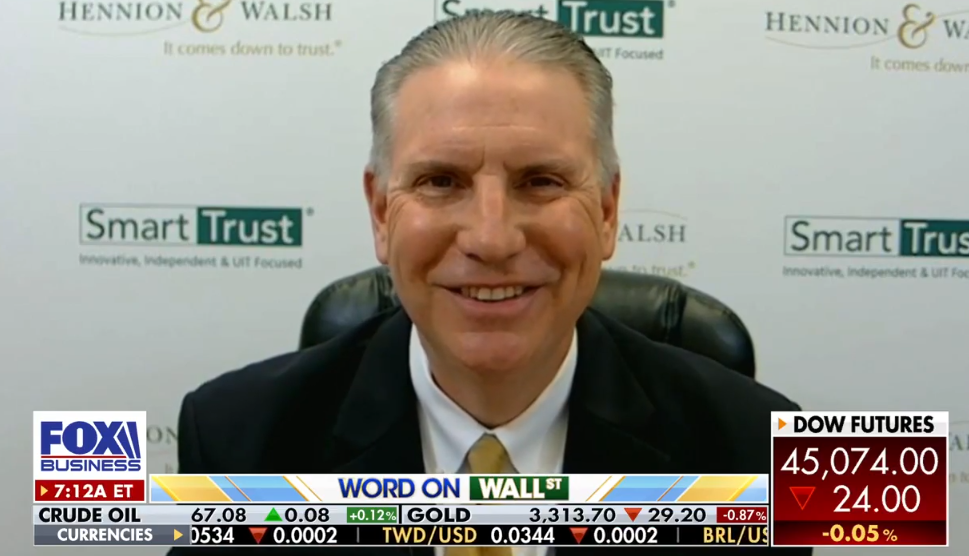
Last Week’s Markets in Review: How Employment may shape Fed Policy

Global equity markets finished lower for the week. In the U.S., the S&P 500 Index traded lower in each of this week’s sessions and closed the week at a level of 4,459, representing a loss of 1.68%, while the Russell Midcap Index moved -0.02% lower last week. Meanwhile, the Russell 2000 Index, a measure of the Nation’s smallest publicly traded firms, returned -2.80% over the week. International equity performance was also lower as developed, and emerging markets returned -0.30% and -0.46%, respectively. Finally, the 10-year U.S. Treasury yield ticked lower, closing the week at 1.35%.
As we have stated many times in this Market Update and other commentaries, we believe that the condition of the employment market will be an important determinant in Fed policy and its timing. In a speech from August 27th speech Chairman Powell stated that he agreed with the majority of his colleagues that if job growth continues it “could be appropriate…this year” to begin tapering the Fed’s monthly asset purchases.
Chairman Powell’s commenter was made prior to several conflicting data points about the status of the national employment picture. Recently, the Labor Department released data showing the U.S. economy added only 235,000 jobs in August, down sharply from roughly 1 million jobs added in July. This past Wednesday, the Labor Department released the JOLTs (Job Openings and Labor Turnover Survey) report for July, which revealed that there were 10.9 million employment positions open, well in excess of the FactSet estimate of 9.9 million openings. The July job openings far exceed the 8.7 million individuals that are out of work and looking for jobs. The last data point that caused confusion was the weekly jobless claims reported on Thursday for the week ended September 4th. The claims totaled 310,000 for a new pandemic era low.

Source: Department of Labor
Fed decision-makers will have to determine the reasons that the July job openings did not materialize into more robust job creation in August and further, why claims are at pandemic lows when there are still 8.7 million Americans looking for work. On a deeper level, the Fed will have to determine if wage inflation will ramp up as demand for workers outpaces those looking for employment. Conversely, if job openings remain at this elevated level will the overall economic recovery slow? tWith continued uncertainty surrounding the spread of the Covid-19 Delta Variant, the Fed will have quite a difficult task at hand in determining its next move. As New York Federal Reserve Bank President John Williams said at an event this week, “The emergence and rapid spread of the Delta variant in parts of the country and around the world have introduced a new layer of uncertainty”.
The condition of the job market and other developments are important factors for investors to consider when managing their investment portfolios. We encourage investors to work with experienced financial professionals to help build and manage the asset allocations within their portfolios consistent with their objectives, timeframe, and tolerance for risk. Best wishes for the week ahead!
As we marked the 20th anniversary of 9/11 this past Saturday, we would also like to pause, reflect and remember all of those lost and the families impacted on that tragic day.
Labor market data is sourced from the Department of Labor. Equity Market and Fixed Income returns are from JP Morgan as of 9/10/21. Rates and Economic Calendar Data from Bloomberg as of 9/10/21. International developed markets measured by the MSCI EAFE Index, emerging markets measured by the MSCI EM Index, U.S. Large Cap defined by the S&P 500. Sector performance is measured using the GICS methodology.
Disclosures: Past performance does not guarantee future results. We have taken this information from sources that we believe to be reliable and accurate. Hennion and Walsh cannot guarantee the accuracy of said information and cannot be held liable. You cannot invest directly in an index. Diversification can help mitigate the risk and volatility in your portfolio but does not ensure a profit or guarantee against a loss.
Diversification can help mitigate the risk and volatility in your portfolio but does not ensure a profit or guarantee against loss.
Investing in commodities is not suitable for all investors. Exposure to the commodities markets may subject an investment to greater share price volatility than an investment in traditional equity or debt securities. Investments in commodities may be affected by changes in overall market movements, commodity index volatility, changes in interest rates or factors affecting a particular industry or commodity.
Products that invest in commodities may employ more complex strategies which may expose investors to additional risks.
Investing in fixed income securities involves certain risks such as market risk if sold prior to maturity and credit risk especially if investing in high yield bonds, which have lower ratings and are subject to greater volatility. All fixed income investments may be worth less than the original cost upon redemption or maturity. Bond Prices fluctuate inversely to changes in interest rates. Therefore, a general rise in interest rates can result in the decline of the value of your investment.
Definitions
MSCI- EAFE: The Morgan Stanley Capital International Europe, Australasia and Far East Index, a free float-adjusted market capitalization index that is designed to measure developed-market equity performance, excluding the United States and Canada.
MSCI-Emerging Markets: The Morgan Stanley Capital International Emerging Market Index, is a free float-adjusted market capitalization index that is designed to measure the performance of global emerging markets of about 25 emerging economies.
Russell 3000: The Russell 3000 measures the performance of the 3000 largest US companies based on total market capitalization and represents about 98% of the investible US Equity market.
ML BOFA US Corp Mstr [Merill Lynch US Corporate Master]: The Merrill Lynch Corporate Master Market Index is a statistical composite tracking the performance of the entire US corporate bond market over time.
ML Muni Master [Merill Lynch US Corporate Master]: The Merrill Lynch Municipal Bond Master Index is a broad measure of the municipal fixed income market.
Investors cannot directly purchase any index.
LIBOR, London Interbank Offered Rate, is the rate of interest at which banks offer to lend money to one another in the wholesale money markets in London.
The Dow Jones Industrial Average is an unweighted index of 30 “blue-chip” industrial U.S. stocks.
The S&P Midcap 400 Index is a capitalization-weighted index measuring the performance of the mid-range sector of the U.S. stock market, and represents approximately 7% of the total market value of U.S. equities. Companies in the Index fall between S&P 500 Index and the S&P SmallCap 600 Index in size: between $1-4 billion.
DJ Equity REIT Index represents all publicly traded real estate investment trusts in the Dow Jones U.S. stock universe classified as Equity REITs according to the S&P Dow Jones Indices REIT Industry Classification Hierarchy. These companies are REITs that primarily own and operate income-producing real estate.



